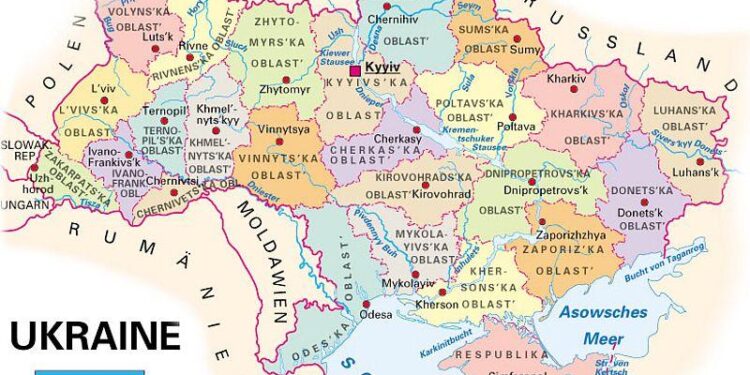As the conflict in Ukraine intensifies, Kyiv faces a mounting challenge from an increasingly sophisticated array of Russian Shahed-136 drones. These unmanned aerial vehicles, deployed with growing frequency and precision, have emerged as a critical threat to Ukraine’s defenses, targeting military installations, infrastructure, and civilian areas alike. In response, Ukrainian forces are scrambling to develop and implement effective countermeasures to mitigate the damage inflicted by these lethal drones. This article examines the evolving nature of the Shahed-136 threat and Ukraine’s urgent efforts to adapt its defensive strategies amid the escalating war.
Ukraine Faces Escalating Threat From Russian Shahed-136 Drones
Ukraine is increasingly confronting a surge in Russian-launched Shahed-136 drones, presenting a significant escalation in the ongoing conflict’s aerial threat landscape. These drones, known for their kamikaze-style attacks, have been deployed in swarms targeting critical infrastructure, supply lines, and military installations. Ukrainian defense forces are scrambling to adapt, investing heavily in counter-drone technologies, electronic warfare measures, and enhanced early-warning systems to detect and neutralize these aerial assaults before they can inflict widespread damage.
Key challenges faced by Ukrainian forces include:
- High drone volume: Russia’s use of massed drone attacks overwhelms existing air defense systems.
- Limited interception capability: Current Ukrainian systems struggle to quickly identify and destroy low-flying, slow-moving drones.
- Technological constraints: Necessity to rapidly develop and deploy advanced radar and jamming equipment.
| Shahed-136 Characteristics | Impact on Ukrainian Defense |
|---|---|
| Range: Up to 2,500 km | Allows deep strikes behind frontlines |
| Payload: Approx. 40 kg warhead | Capable of disabling key infrastructure |
| Speed: Low subsonic | Harder to detect with radar |
| Launch pattern: Swarm attacks | Strains Ukrainian air defense resources |
Analyzing Ukraine’s Tactical Response and Air Defense Adaptations
Faced with an escalating barrage of Russian Shahed-136 kamikaze drones, Ukrainian forces have dramatically shifted their tactical posture to minimize losses and disrupt enemy targeting cycles. Commanders are increasingly dispersing critical assets, integrating mobile air defense units, and implementing layered surveillance protocols to detect and engage low-signature UAVs before they reach key infrastructure. This agile approach has also included deploying decoys and electronic warfare systems to confuse incoming drones, reducing the effectiveness of enemy guidance mechanisms. Notably, ground units have been trained in rapid response maneuvers, allowing for rapid redeployment of air defense platforms in response to evolving attack vectors.
Key adaptations deployed by Ukrainian forces include:
- Enhanced radar integration for early drone detection at multiple altitudes.
- Utilization of short-range MANPADS and automatic cannons optimized for low-flying threats.
- Implementation of drone-hunting drone units to intercept and disable Shahed-136s mid-flight.
- Advanced electronic countermeasures targeting enemy command links.
In addition to tactical evolutions, Ukraine has revamped its air defense asset allocation, prioritizing high-value urban centers and critical logistical nodes. The reorganization can be summarized in the following table:
| Defense Priority | Asset Focus | Deployment Strategy |
|---|---|---|
| Urban Centers | Short-range SAMs & Anti-Drone Guns | Clustered with overlapping fields of fire |
| Logistical Hubs | Mobile Radar & Electronic Warfare Units | Flexible, redeployable groups to safeguard supply routes |
| Command Posts | Integrated Sensor Network & Decoys | Camouflage and active countermeasures |
Experts Call for Enhanced Intelligence Sharing and Advanced Countermeasures
Military analysts emphasize that the escalating threat posed by the Russian Shahed-136 drones necessitates a robust upgrade in Ukraine’s intelligence capabilities. Frontline commanders and technical experts alike are advocating for the accelerated integration of real-time intelligence sharing platforms to improve the detection and interception rates of these low-cost, high-impact loitering munitions. Enhanced collaboration between intelligence units, electronic warfare divisions, and air defense batteries is crucial for constructing a comprehensive threat picture that can anticipate and neutralize drone attacks before they reach critical infrastructure or troop concentrations.
Key recommendations from defense experts include:
- Deployment of advanced radar and sensor arrays specifically tuned to detect low-altitude, slow-moving drones
- Establishment of multi-agency intelligence fusion centers to streamline data flow and operational coordination
- Investment in AI-driven counter-drone systems capable of rapid target classification and electronic jamming
- Strengthened international intelligence cooperation, leveraging insights from global drone warfare experiences
| Countermeasure | Effectiveness | Implementation Timeline |
|---|---|---|
| AI-Powered Jammer Systems | High | 6-12 Months |
| Enhanced Radar Coverage | Medium-High | 3-6 Months |
| Real-Time Intelligence Fusion | High | Immediate |
| International Data Sharing Agreements | Medium | Variable |
The Conclusion
As the conflict continues to evolve, Ukraine faces mounting challenges in countering the persistent threat posed by Russia’s Shahed-136 drones. With limited resources and increasing attacks, Ukrainian forces are urgently adapting their defense strategies to mitigate the drone’s impact on critical infrastructure and civilian areas. The situation remains fluid, underscoring the broader complexities of modern warfare where unmanned systems play an increasingly pivotal role. Observers will be watching closely to see how Kyiv’s efforts to neutralize this emerging threat develop in the coming weeks.
















